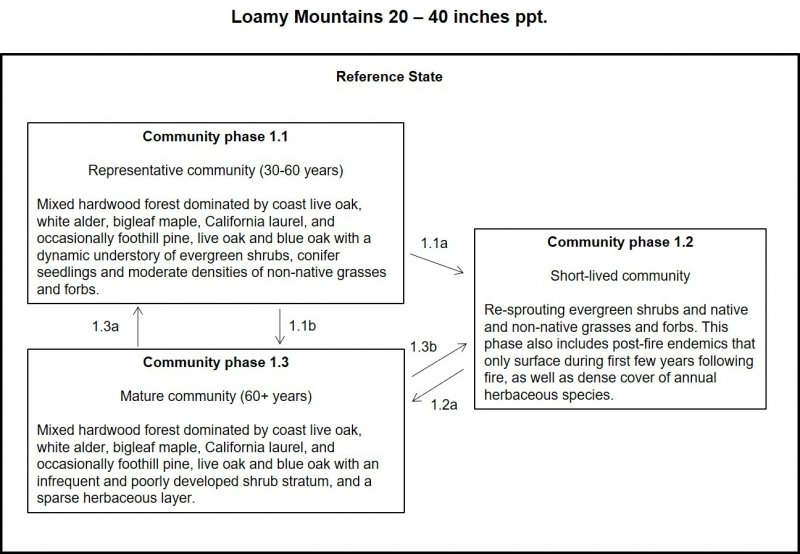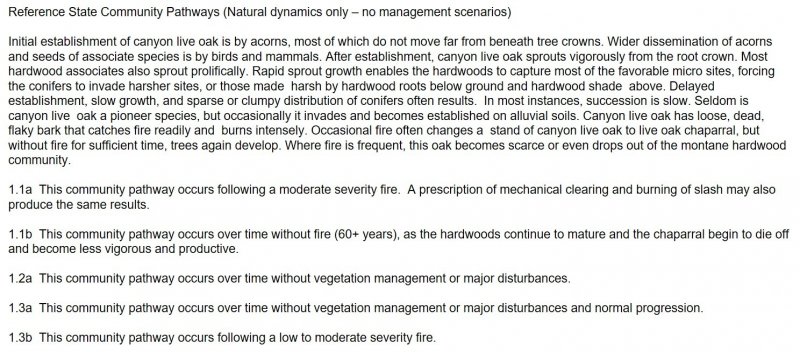Ecological site group R015XY014CAESG
Loamy Mountains 20-40"ppt
Last updated: 09/07/2023
Accessed: 12/22/2025
Ecological site group description
Key Characteristics
- located on mountains
- loamy texture
- 20-40" ppt
Provisional. A provisional ecological site description has undergone quality control and quality assurance review. It contains a working state and transition model and enough information to identify the ecological site.
Physiography
This ESG is typically found on mountain slopes from 10 to 75 percent. Elevations typically range from 500 to 5000 feet (can be up to 5700 ft in some areas).
Climate
The average annual precipitation in this area is typically 11 to 39 inches. Snowfall is common in the northern half of the part north of San Francisco and rare elsewhere. Precipitation is evenly distributed throughout fall, winter, and spring but is very low in summer. Coastal areas receive some moisture from fog in summer. Most of the rainfall occurs as low- or moderate-intensity, Pacific frontal storms during the period October to May. The average annual temperature is 52 to 65 degrees F (11 to 18 degrees C), decreasing from south to north. The freeze-free period averages 275 days and ranges from 180 to 365 days, decreasing in length with elevation and from south to north.
Soil features
Soils in this ESG consist mainly of moderately deep to deep, well drained to somewhat excessively well drained soils that formed mostly from residuum materials.
The soils that represent this ESG include:
Junipero, a coarse-loamy, mixed, superactive, mesic Pachic Ultic Haploxerolls
Los Gatos, a fine-loamy, mixed, active, mesic Typic Argixerolls
Maymen, a loamy, mixed, active, mesic, shallow Typic Dystroxerepts
Sur, a loamy-skeletal, mixed, superactive, mesic Entic Haploxerolls
Vegetation dynamics
This ESG covers the mesic (cool) areas of the uplands that receive more than 20 inches but less than 40 inches of precipitation each year in MLRA 15 that were at one time part of a vast complex of montane hardwoods that intermixed with conifers. The fragmented and urbanized landscape in these coastal mountains within this MLRA that exists today makes it difficult to imagine the natural landscape prior to human development.
Canyon live oak and associates are found on a wide range of slopes, especially those that are moderate to steep. Soils are for the most part rocky with variable loamy soil textures, poorly developed, and well drained with soil depth classes ranging from moderately deep to deep. Canyon live oak, incense-cedar, and a few other associates are also found on ultrabasic soils. In the Coast Range and Klamath Mountains, canyon live oak often forms pure stands on steep canyon slopes and rocky ridge tops. It is replaced at higher elevations by huckleberry oak. At higher elevations, it is scattered in the overstory among ponderosa pine, Coulter pine, California white fir, and Jeffrey pine, the latter on serpentine and peridotite outcrops. Middle elevation associates are Douglas-fir, tanoak, Pacific madrone, California-laurel, California black oak, and bristlecone fir. Knobcone pine, foothill pine, Oregon white oak, and coast live oak are abundant at lower elevations. Understory vegetation is mostly scattered woody shrubs (manzanita, mountain-mahogany, poison-oak) and a few forbs.
A typical montane hardwood habitat is composed of a pronounced hardwood tree layer, with an infrequent and poorly developed shrub stratum, and a sparse herbaceous layer. On better sites, individual trees or clumps of trees may be only 3 to 4 m (10 to 13 ft) apart. On poorer sites, spacing increases to 8 to 10 m (26 to 33 ft). Where trees are closely spaced, crowns may close but seldom overlap. Living crowns on mature canyon live oaks occupy about 60 percent of the bole on typical sites and up to 80 percent on poor sites. Tree heights tend to be uniform at most ages in mature stands where hardwoods occur, but subordinate to conifers. Mature oaks on better sites and in canyons range between 17 and 30 m (56 and 98 fl) tall and up to 150 cm (59) in) dbh. On poorer sites, mature trees typically are 10 to 15 m (33 to 49 ft) tall with boles up to 65 cm (26 in) in dbh, with dome-shaped crowns almost as wide as the trees are tall. On rocky summits, canyon live oak is a shrub of small diameter, usually less than 4 m (13 ft) in height. Snags and downed woody material generally are sparse throughout the montane hardwood habitat.
Initial establishment of canyon live oak is by acorns, most of which do not move far from beneath tree crowns. Wider dissemination of acorns and seeds of associate species is by birds and mammals. After establishment, canyon live oak sprouts vigorously from the root crown. Most hardwood associates also sprout prolifically. Rapid sprout growth enables the hardwoods to capture most of the favorable micro sites, forcing the conifers to invade harsher sites, or those made harsh by hardwood roots below ground and hardwood shade above. Delayed establishment, slow growth, and sparse or clumpy distribution of conifers often results. In most instances, succession is slow. Seldom is canyon live oak a pioneer species, but occasionally it invades and becomes established on alluvial soils. Canyon live oak has loose, dead, flaky bark that catches fire readily and burns intensely. Occasional fire often changes a stand of canyon live oak to live oak chaparral, but without fire for sufficient time, trees again develop. Where fire is frequent, this oak becomes scarce or even drops out of the montane hardwood community.
A type more stable than Montane Hard wood is difficult to envision. The large number of species in the type, both conifer and hardwood, allow it to occupy and persist in a wide range of environments. Good soils and poor, steep slopes and slight, frequently disturbed and pristine all are at least adequate habitats for one or more species. Longevity (at least 300 years for some species), and large size help to ensure dominance. Seed and sprout reproductive modes assure both widespread and stationary reproduction, and consequently several age and size classes usually are present in most areas. Growth of most hardwoods, especially canyon live oak, generally is slow and depends on depth and rockiness of soil, slope, and possibly length of time for roots to reach groundwater.
Information from:
California Wildlife Habitat Relationships System
California Department of Fish and Game
California Interagency Wildlife Task Group
Philip M. McDonald
Major Land Resource Area
MLRA 015X
Central California Coast Range
Stage
Provisional
Contributors
Kendra Moseley
Darren Pinnegar
Darren
Click on box and path labels to scroll to the respective text.

